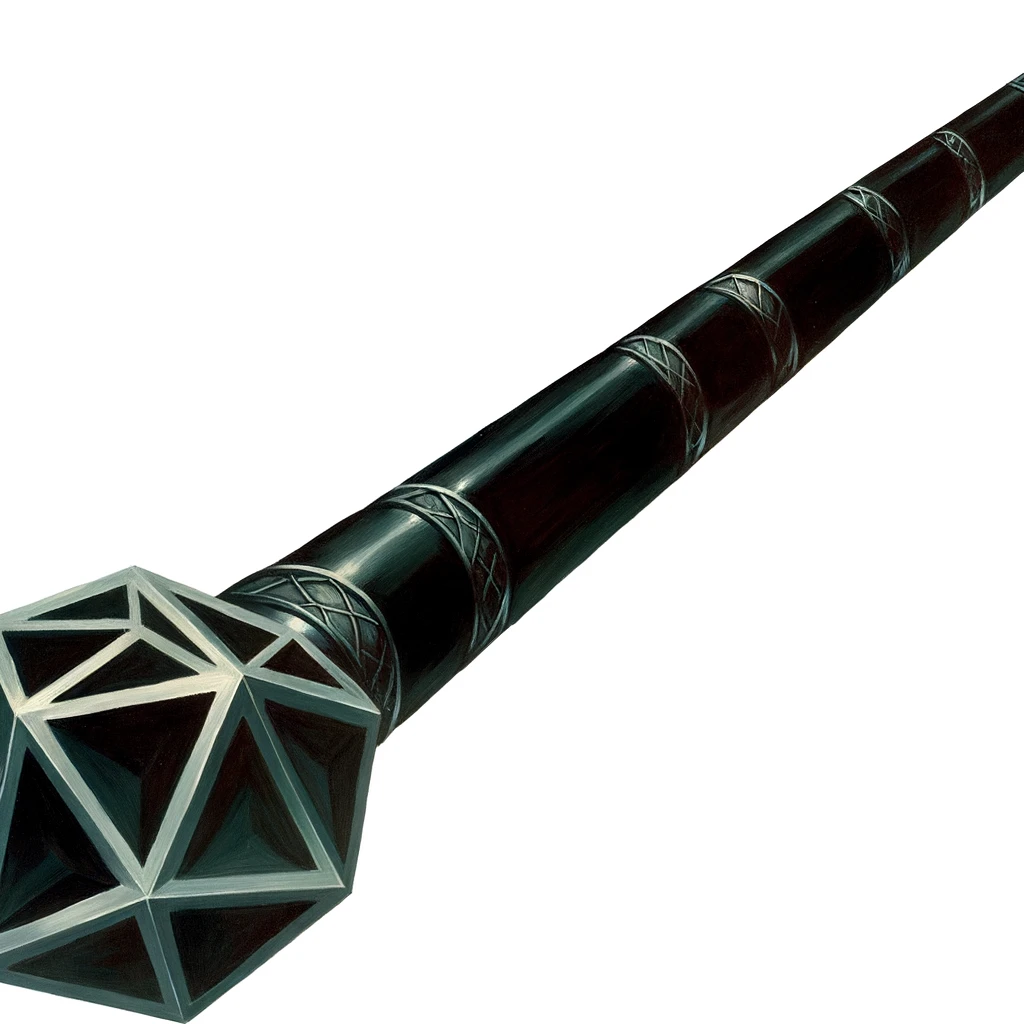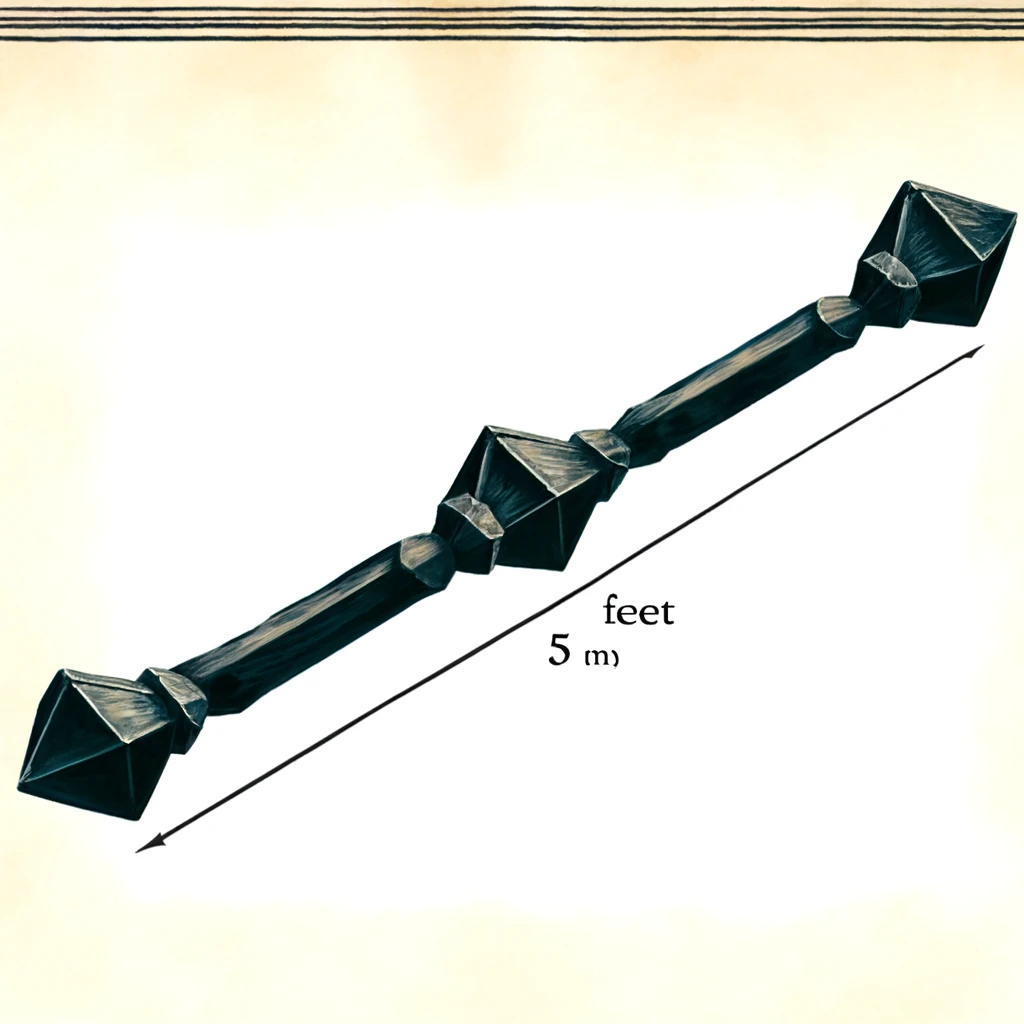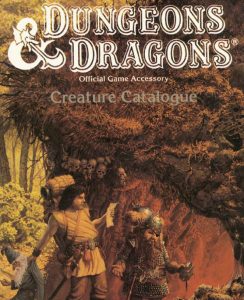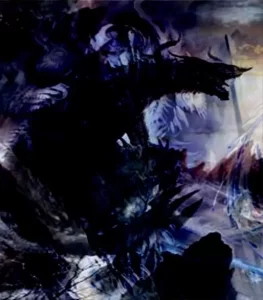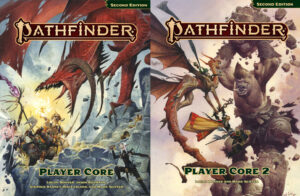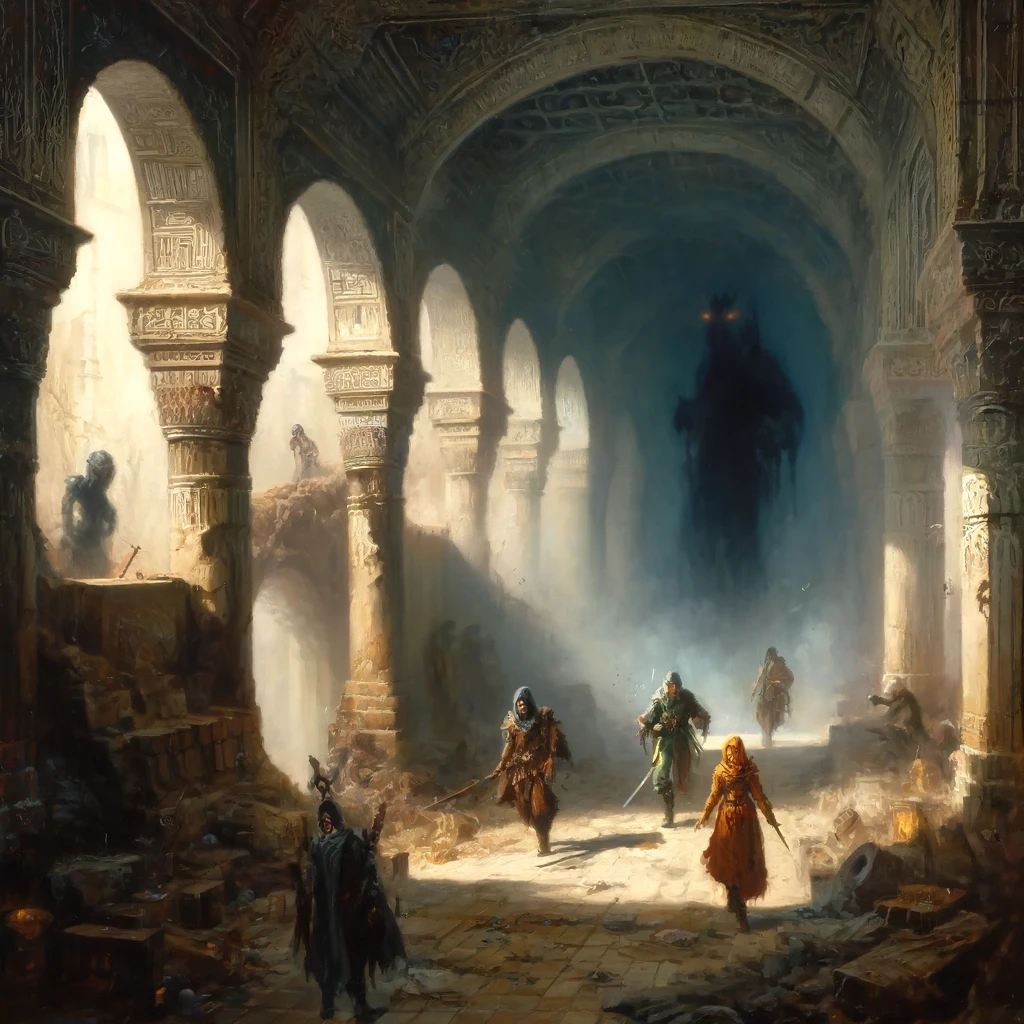
Oil painting adventuring party navigating the eerie, decrepit hallways, with danger lurking.
A Timeless Artifact and Its Guardians
Book 3 of "The Rod of Seven Parts" plunges players into the heart of an epic Dungeons & Dragons adventure, drawing on the rich history of the game's lore. At the core of this narrative is the legendary artifact itself - the Rod of Seven Parts. Known for its power to influence the cosmic battle between Law and Chaos, this artifact's segments, when fully assembled, can have game-changing effects on any campaign.
The Rod's origin is steeped in the ancient war between the elemental forces of Law and the anarchic waves of Chaos. Crafted by the Wind Dukes of Aaqa, the Rod was shattered in a climactic battle that left its pieces scattered across the multiverse. Each segment, imbued with unique powers, poses both a promise and a peril to those who dare to seek them.
The Haunted Caravanserai: A Portal to Danger
A key chapter in Book 3 centers around a desolate caravanserai, now a haven for malevolent forces. This forgotten outpost sets the stage for a dramatic confrontation with Ibbitsaad al Puhr and Naala bint Tekkne, two scheming efreet who, along with their retinue of medusae, jann, an imp, and mephits, have turned the caravanserai into a deadly trap. The narrative masterfully depicts their insidious plan to capture travelers and sell them into the slave markets of the City of Brass, capitalizing on the supernatural dread that pervades the area.
The setting is vividly described, with the sandy winds and scorching sun of the surrounding desert accentuating the ominous ambiance of the caravanserai. The adventurers, guided by the magical Rod, find themselves drawn to this haunted locale, where every corner and shadow may conceal a deadly threat.

Magical Items and Powers: Enriching the Gameplay
The book excels in expanding the arsenal of magical items and powers available to players. Noteworthy among these are the new magical items such as the Vaati Blade and the Ointment of Protection from Fungi, each with their own rich backstory and tactical utility. Moreover, the detailed explanation of the Rod's powers - ranging from the minor magical effects of individual segments to the major and resonant powers when combined - provides players and Dungeon Masters alike with creative ways to integrate the Rod into their gameplay.
Further enhancing the gameplay are the additions of unique and diverse items like the Wand of Vapors and the Wind Chariot. The Wand of Vapors, crafted from exotic materials like ivory and smoky quartz, offers a variety of effects including creating dense fogs and deadly gases, which can drastically alter the dynamics of combat and exploration. Similarly, the Wind Chariot, a relic from the ancient vaati culture, grants unparalleled mobility across the battlefield and protective barriers against environmental hazards, adding a layer of strategic depth to player movements and positioning.
The compendium also delves deeper into the mystique of the Rod by detailing the intricate process involved in its reassembly. This process is not only a physical challenge but also a test of the adventurers' wit and resolve, as it involves decoding ancient glyphs and conducting extensive magical research. The potential for the Rod to teleport randomly when segments are brought too close, without the proper precautions, injects a thrilling element of unpredictability into the quest.
Moreover, the Rod's influence extends beyond its immediate magical effects. It subtly - or sometimes overtly - affects the personalities and moral compasses of its bearers. This transformation is reflected through detailed narrative elements that explore the ethical dilemmas and internal conflicts faced by the characters in possession of the Rod's segments. Such features ensure that the Rod of Seven Parts is not merely a powerful artifact but also a catalyst for character development and storytelling.
Together, these elements make Book 3 of "The Rod of Seven Parts" not only a treasure trove of new magical items and powers but also a profound narrative experience that challenges players to think critically about the consequences of wielding such power. Whether it's strategizing the use of the Rod's segments or dealing with the ethical ramifications of its influence, this book offers a comprehensive and immersive adventure that is sure to enrich any Dungeons & Dragons campaign.
Impact on Characters: A Double-Edged Sword
One of the most intriguing aspects of Book 3 is the exploration of the Rod's influence on those who wield it. The segments of the Rod, even when held separately, begin to exert a lawful influence over the bearer, slowly reshaping their alignment towards Lawful Neutral. This gradual transformation can lead to significant character development or conflict, particularly for those whose original alignments or class commitments conflict with the Rod's influence.
As adventurers collect more segments of the Rod, the influence intensifies, demanding greater moral fortitude and offering rich opportunities for role-playing. For example, a character who typically acts on impulse may find themselves compelled to consider the consequences of their actions more carefully, striving to bring order to their once chaotic nature. This shift can create internal struggles and dynamic interactions within the party, as characters grapple with the Rod's push towards lawfulness.
Furthermore, the book details specific scenarios and consequences for characters who resist or embrace the Rod's influence. Dungeon Masters are provided with guidelines on how to handle such transformations, including potential penalties or bonuses that reflect the inner turmoil or harmony experienced by the characters. This not only adds a layer of complexity to character development but also enhances the narrative arc of the campaign.
The transformation also extends to the physical and social interactions of the characters. Those who align with the Rod's influence may find themselves in positions of leadership, entrusted with making decisions that align with law and order. Conversely, those who resist might face mistrust or conflict from those who have embraced the Rod's power. This dynamic can lead to pivotal moments in the campaign, where characters must choose between their previous life paths and the new directions forged by the Rod's influence.
Ultimately, Book 3 uses the Rod as a profound narrative device that challenges players to explore the philosophical and ethical dimensions of power and governance. It encourages players to reflect on how much they are willing to change or sacrifice for the greater good, making "The Rod of Seven Parts" not just a quest for a powerful artifact, but a journey of self-discovery and moral reckoning.
More Details of Adventure
In addition to the detailed exploration of magical items and the Rod's transformative powers on its bearers, Book 3 of "The Rod of Seven Parts" also delves into the intricate process of assembling and disassembling the Rod, which is fraught with both mystical challenges and potential calamities.
Assembling the Rod: The assembly of the Rod involves not just the physical act of joining the segments but also requires special glyphs to prevent the pieces from teleporting away when brought together. These glyphs are akin to those used in magical scrolls and require specific materials and knowledge to create. The process is so sensitive that any misstep can cause the segments to scatter across great distances, complicating the quest significantly .
Disassembling the Rod: Disassembling the Rod is equally complex, necessitating a reversed form of the assembly glyphs. If done incorrectly, this too can result in the Rod's segments teleporting away, scattering their powers and erasing any progress made by the wielders. This aspect of the Rod highlights the volatile nature of such a powerful artifact, where every interaction with it can lead to unforeseen consequences .
Resonant Powers of the Rod: When assembled correctly, the Rod exhibits resonant powers that significantly enhance its abilities. These powers are not just extensions of the Rod's capabilities but are often magnified or altered properties that provide substantial advantages to the bearer. However, the risk of incorrect assembly looms large, potentially negating these powerful benefits and leading to disastrous outcomes .
Lawful Influence: The Rod's influence extends beyond the physical realm, affecting the ethical stances of its wielders. As segments are added, the bearer's alignment gradually shifts towards Lawful Neutral, regardless of their original disposition. This shift can lead to significant role-playing opportunities, where characters must grapple with internal changes that may conflict with their previous beliefs and alliances .
These elements from Book 3 not only enhance the gameplay by adding layers of complexity and risk but also enrich the narrative, making the quest for the Rod a deeply engaging and potentially transformative journey for the characters involved.
A Rich Addition to the D&D Universe
Book 3 of "The Rod of Seven Parts" is a treasure trove of adventure, intrigue, and mystical lore. It challenges players not only with physical adversaries but also with quandaries and the burden of power. The detailed settings, elaborate magical items, and the deep lore surrounding the Rod make this book an invaluable resource for enriching any D&D campaign. Whether you are a seasoned adventurer or a novice to the realms of fantasy role-playing, "The Rod of Seven Parts" offers a gateway into stories that are as compelling as they are fantastical.
Moreover, the book skillfully weaves complex character development into the fabric of its narrative, offering players opportunities to explore the implications of their choices and the ethical dimensions of wielding great power. As characters interact with the Rod, they must confront and manage the changes it imposes on them, providing a rich ground for dynamic role-playing that goes beyond mere combat and treasure hunting. This interaction not only deepens the personal narratives of the characters but also significantly impacts the progression of the overall storyline, making each decision and action part of a larger, unfolding epic.
Additionally, Book 3 emphasizes the interconnectedness of the various elements within the game's universe. The places, items, and characters players encounter are not isolated; they are part of a broader context that players can engage with and influence. This holistic approach not only enhances the immersive experience of the campaign but also encourages players to think strategically about the broader implications of their adventures.
"The Rod of Seven Parts" is more than just a quest for a legendary artifact; it is a multi-faceted exploration of power, responsibility, and identity within the fantastical world of Dungeons & Dragons. The narrative complexity, coupled with the deeply integrated game mechanics, makes this book a must-have for both players and Dungeon Masters looking to elevate their gaming experience to new heights of creativity and challenge.
The Rod of Seven Parts - Book 3 PDF
The Rod of Seven Parts - Monster Manual
Miscellaneous PDF of The Rod of Seven Parts
What does the Rod of Seven Parts Look like?
The Rod of Seven Parts, a legendary artifact featured in Book 3 of the Dungeons & Dragons series, is intricately detailed, both in narrative and physical description. When fully assembled, the Rod measures five feet in length. Its design features a rounded base approximately two inches in diameter, tapering to an end as thin as a man's little finger. This gradation in size is split across the Rod's seven segments, each uniquely sized at 4, 5, 6, 8, 10, 12, and 15 inches, respectively. The segments are described as having complex geometric facets-both protrusions and depressions-that allow them to fit together like pieces of a three-dimensional puzzle.
Further enhancing its mystical allure, the Rod's segments are made from a lusterless black substance, transformed by the blood of Miska, a pivotal figure in the artifact's lore. This mysterious material has a peculiar quality; it feels substantial to the touch, yet its weight is indeterminate, neither particularly light nor heavy. When held, a segment of the Rod feels significant yet strangely weightless, contributing to the enigmatic nature of this powerful artifact. The fully assembled Rod weighs about seven pounds but astonishingly feels as light as a feather, embodying the paradoxical characteristics that make it both a formidable tool and a profound burden for those who seek to wield its power.
